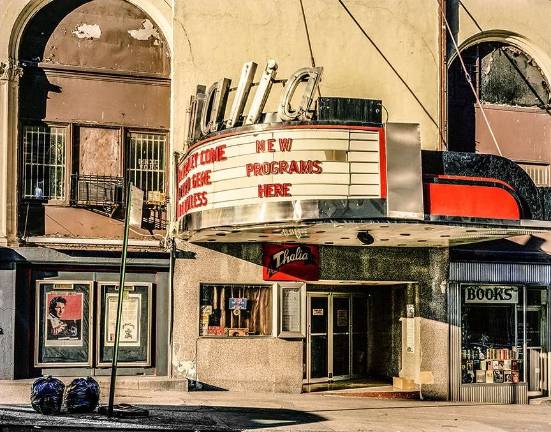reeling in the years

There was a time, before DVDs, before VHS, when there were only two places to see classic movies of the past: museums and revival theaters.
There were quite a few revival theaters in New York, and one of the best-known was the small Thalia theater, on West 95th Street just west of Broadway. Hard-core film buffs would eagerly peruse the ads in the Village Voice and other papers back then just to see what would be playing in these theaters. The Thalia’s offerings ranged from “Easy Rider” to “The Lady Vanishes,” from “A Day at the Races” to “Glen or Glenda.”
Back in the ‘80s, one of my co-workers in the New York City Housing Authority, whose job it was to show movies at NYCHA-affiliated senior centers, was a film buff. One weekend, she excitedly asked me to go to the Thalia. “Two Barbara Stanwyck movies from the 1940s are playing!” she said. I didn’t know who Barbara Stanwyck was, but I soon found out that she was one of the great ladies of the screen in the ‘30s and ‘40s, on a par with Bette Davis and Lauren Bacall.
The much-loved Art Deco movie house opened in 1931 in a building that also houses the much larger Symphony Space (today’s Thalia is actually part of Symphony Space, but more about that later). In the 1940s, it was known for showing foreign films. In the ‘50s, it began showing Hollywood classics as well. The Thalia’s longtime owner, who died in 1955, was named Martin Lewis, which is interesting because it’s almost certain that the Thalia, at one time or another, screened films by the famous 1950s comedy duo of Dean Martin and Jerry Lewis.
Lewis’ widow, Ursula, retired from managing the theater in 1973. In 1977, a new owner, Richard Schwartz, bought the theater, which had deteriorated, and installed new seating, repaired the ceiling, repainted the walls and displayed Al Hirschfeld caricatures of movie greats of yesteryear. He continued showing classic and foreign films. The Thalia also gained newfound fame when it was used as one of the locations for Woody Allen’s “Annie Hall.”
The Thalia did well for many years, but eventually, like many theaters, it began losing money. The ‘80s, don’t forget, saw a boom in video stores and VHS recorder/players. On weekends, these stores were always busy. While most video stores specialized in mainstream movies, there were stores — especially in neighborhoods like the West Side — that carried classics and foreign films. The Thalia closed its doors in 1987. It reopened in 1993 under new management and operated on and off with several different policies (art films again, African films, Indian films, live comedy shows) only to close again in 1999.
In April of that year, after Symphony Space sold its property and air rights to the Related Companies, builders who were preparing to construct an apartment tower above the building gutted the Thalia’s interior. Local preservationists decried the move. “After Radio City Music Hall, the Thalia was probably the most interesting Art Deco cinema in New York City,” architectural historian Michael Godkin in The Times.
The Thalia was basically saved by a $1.5 million donation from none other than Leonard Nimoy, he of Star Trek fame. The donation helped Symphony Space rehabilitate the theater and reopen it in 2002.
The 168-seat theater is now known as the Leonard Nimoy Thalia, and still screens films.